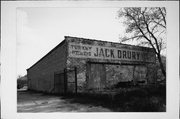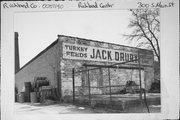| Additional Information: | Architectural/Engineering Significance:
The Krouskop Lumber Yard does not meet the NRHP criteria for architectural significance because of a lack of integrity. However, the former Krouskop Dry Kiln contributes to the historic character of proposed Krouskop Lumber Yard Historic District.
Historical Background:
The Krouskop Lumberyard Dry Kiln is a part of the Krouskop Lumberyard whose main mill was erected in 1883. Krouskop may have established the operation as early as 1878. However, he did not acquire most of the land which the milling operation occupies until 1879-1880. His operations eventually covered the area between the river to the west, Haseltine to the north, Main on the east extending to Central to include block 49, and Gage Street to the south (1). The 1883 mill structure burned in 1892, and Krouskop rebuilt and considerably expanded the brick mill by 1893 (2).
The yard reached full built capacity by 1911. Major buildings at that date included a saw and planing mill with a power house, lumber sheds, kiln, yard office, granary, an agricultural implement warehouse, grain warehouse, livestock yards, and the horse barn. The yard sat adjacent to the railroad, a facility indispensable to the transportation of its bulk products. Krouskop shipped many of his goods to Chicago for a broad distribution across the Midwest and Plains as well as engaging in local retail.
Krouskop wholesaled and retailed rough and finished lumber, sashes and doors, windows, oak flooring, moldings, siding, shingles, lathe, fencing, agricultural implements, and other building supplies. He also stored grain, feed, hay, coal, cement, and sand and kept livestock. Krouskop specifically advertised his wholesale business in 1909. He had maintained lumber warehouses occupying several blocks since the mid-1880's which suggests the extent of his business. Krouskop represents one of a limited number of commercial enterprises in Richland Center. After Krouskop's death in 1930, W.S. McCorkle and Carl Barnes gained his lumber operation (3).
The Krouskop Lumberyard Dry Kiln was erected between 1899 and 1905. In the recent past, it was used for turkey feed storage. Such steam dry kiln were often added by large lumberyards, especially those with planing mills and attendant machinery such as edgers, set laths, band saws, and planers, they put out finished products such as flooring, lathe, sashes, doors, and blinds (4). The Krouskop mill was operated as such a mill (5).
Historical Significance:
The Krouskop Lumberyard Dry Kiln is an historically contributing component of the Krouskop Lumberyard Historic District. It acquires local historical significance under Criterion A in association with the Milling and Wood Products Topic of the Industry Theme. The dry kiln is frequently identified with larger lumberyards as well as those which produce finished products as opposed to simply rough lumber. This trend was characteristic of late nineteenth century mills in the hardwood belt (6). Its period of significance begins with the power houses' construction in 1899 to 1905 and ends with Krouskop's disassociation with the lumberyard through his death in 1930.
While the lumber milling industry developed early, markets did not rapidly expand until the 1870's when settlement of the prairies and the building of the railroad network to reach it had developed. Relying primarily on hardwoods, Richland Center's milling industry emerged with the processing of wood products in the late 1870's and 1880's. Lumber milling collapsed in most areas by the turn of the century. Richland Center's milling operation emerged during Wisconsin's years of peak production in the late 1880's and early 1890's (7). However, Richland Center's largest lumber mill and wood products manufacturer, the Krouskop Lumberyard, survived through not only milling but other areas of commerce and retail. It is the only surviving milling operation of the three which emerged in the late nineteenth century along the Pine River. The other two include the N.L. James lumber mill and the Parfrey mills (8).
Thus, although with the exception of Krouskop's Lumberyard much of the built environment no longer remains, the lumber industry contributed heavily to the economic development of Richland Center from the 1880's to the 1920's. It represents a common second phase in Wisconsin's industrial growth between the emphasis on flour milling and the dairy industry. Richland Center's development typifies the emergence of many southern Wisconsin communitites located within the mixes forest belt (9). However, because the development of their lumber industry paled economically by comparison to those located in the pineries, the rise of this portion of the lumber industry is less well understood. The Krouskop Lumberyard Dry Kiln constitutes a local remnant of this once important industry.
|
|---|
| Bibliographic References: | 1. Richland County Abstract Company, Indices to Land Records in the Richland 1. County Courthouse (Richland Center: Richland County Abstract Company, n.d.); Democrat, April 9, 1930; Sanborn-Perris Map Company, Diagrammatic and Detailed City Maps Published for Use by Fire Insurance and Mortgage Companies (New York and Chicago: Sanborn-Perris Map Company, 1885-86); Ibid., 1892; Ibid., 1899; Ibid., 1905; Ibid., 1912; Ibid., 1927.
2. Democrat, May 3, 1937; Margaret Scott, Richland Center: A History (Richland Center: Richland County Publishers, 1972), p. 97.
3. Perl L. Lincoln, P.L. Lincoln Papers (Richland Center: Local History Room, Brewer Library, n.d. [Mss. Uncatalogued]); Carl Burdock, The Chicken, the Egg, and the Omelet (Madison: Archives [Mss.], State Historical Society of Wisconsin, 1964); George Sinnett, Oral Interview (739 South Park, Richland Center, February 12, 1988); Local History Room, Brewer Library, Manuscrips (Richland Center: Local History Room, Brewer Library, Mss. 1645, 1073, 226); Sanborn-Perris Map Company, Ibid., 1885-6; Ibid., 1892; Ibid., 1899; Ibid., 1905; Ibid., 1912; Ibid., 1927; Scott, Ibid., pp. 158, 223; R.L. Polk & Co., Wisconsin Gazetteer and Business Directory (Chicago: R.L. Polk & Co., 1909),p. 1131.
4. Richard Current, The History of Wisconsin: The Civil War Era, 1848-1873 (Madison: State Historical Society of Wisconsin, 1976), pp. 667-70; Robert C. Nesbit, The History of Wisconsin: Urbanization and Industrialization, 1873-1893 (Madison: SHS of Wisconsin, 1985) pp. 54-55, 82-83, 159, 189, 305, 309.
5. Burdock, Ibid.; Sanborn-Perris Map Company, Ibid., 1899; Ibid., 1905; Sinnett, Ibid.; C.W. Butterfield, History of Crawford and Richland Counties (Springfield: Union Pubishing Company, 1884), P. 1151; Republican Observer, May 17, 1883, p. 1.
6. Nesbit, Ibid., pp. 82-83, 159, 189, 305, 309.
7. Barbara Wyatt, Cultural Resource Management in Wisconsin (Madison: Historic Preservation Division, SHS, 1986), [Industry], II, 5-11, 14-15; Robert C. Nesbit, The History of Wisconsin: Urbanization and Industrialization, 1873-1893 (Madison: SHS, 1985), pp. 80, 310, 471; Scott, Ibid., 71.
8. Sanborn-Perris Map Company, Ibid., 1885-86; Ibid., 1892, Ibid., 1899, Ibid., 1905; Ibid., 1912; Ibid., 1927; Burdock, Ibid.
9. Burdock, Ibid.; Sinnett, Ibid; Nesbit, Ibid., pp. 54-55, 82-83; Wyatt, Ibid., 5-8, 12-13; Richard Current, The History of Wisconsin: The Civil War Era, 1848-1873 (Madison, SHS, 1976), pp. 467-70.
A. Sanborn Insurance Map, City of Richland Center (New York: Sanborn Map Co., 1982-1927).
B. Inscription on building. |
|---|


